Over a year ago, when Knights of the Frozen Throne was revealed as an expansion, I made the inaugural post of “Carmen says”. Back then was the first “public” beta-test of Carmen’s ability to evaluate cards, and she didn’t know too much. With the announcement of Rastakhan’s Rumble, me and Carmen will be working hard to teach her more about the game of Hearthstone, so hopefully by the time the next expansions hits, she will be so good at predicting a card’s strength that her knowledge will obsolete all other predictions.
Now, a summary of how Carmen rates cards:
- All types of cards are rated separately – minions, weapons, spells and heroes (spoiler alert, Carmen is still confused by hero cards and blacks out when she sees one).
- She only knows of a card’s overall power level, which is represented by a single number that is the card’s Rating.
- Carmen doesn’t understand what a “meta” is, so her ratings don’t (yet!) take into account the existence of other cards.
- She is also slightly colourblind, and until I can treat her condition, she can’t really differentiate between different classes as well.
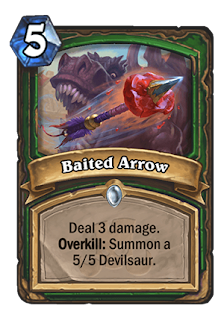 |
| Carmen says – 12 |
Baited arrow: At first glance, this card seems amazing, however it will live and die with the Overkill mechanic. This wants to target 1- and 2-health minions, obviously, though it has the added benefit of being able to go straight to the dome for a little bit of extra reach whenever that’s relevant (though obviously Overkill doesn’t matter there). The most obvious comparison is Flanking Strike, which costs 1 mana less, can target 3-health minions but only nets a 3/3 in return.
As long as there is small stuff in the meta, Hunter decks should want to play this. Whether or not a deck can afford to find a spot for this card will depend on how synergy-focused it is, but if we ever get back to a Midrage Hunter era, this card will define the 5-drop slot. Trading your smaller minions into something bigger only to overkill it with Baited Arrow will feel very rewarding, as it is a huge tempo swing. A 5/5 minion is on the bigger side for the midgame and trades very favourably with almost anything at that stage. Even if it doesn’t see play immediately, next year Hunter’s options will dwindle and if a deck is looking for playables, this card should be on the top of most lists.
Verdict: High potential for a Hunter staple, especially post-rotation.
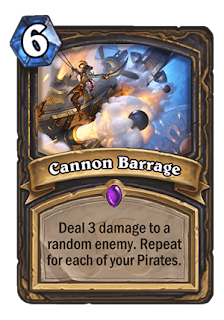 |
| Carmen says – 8 |
Cannon Barrage: Speaking of cards that live and die by the relevance of something else, Cannon Barrage is the perfect example. How often will you have enough pirates on the board to make this worth your time? Pirates says aggro, or some form of aggressive midrage deck at best. We will have to see the new pirates that come out in the Rumble, but historically they have been very flimsy, with 1 or 2 health most of the time. Then we have to factor in the insane cost of this card. Rogue, as always, continues to pay for Preparation’s sins. With a generous assumption of 3 pirates on the board, this is essentially a Greater Arcane Missiles, all but a single mana cheaper.
 |
| Carmen says – 19 |
Hex Lord Malacrass: First interesting card of the day, so let’s break it down. At face value, this is a card generator. You’re spending 8 mana to get anywhere from 2 to 4 cards, of which two are good since you put them in your deck (you can be on the play for 3 cards or on the draw for an extra coin, but you can also unwillingly get this card in the opening hand if you don’t get to explicitly mulligan it away). I’d like to think of it as getting 3 cards. There’s also a 5/5 body for your troubles, but I think a vanilla 5/5 in the late game is nothing to get excited about – without even a soft Taunt, it will go ignored by most board states.
 |
| Carmen says – 47 (She’s generously treating it as a 3/3 and she still doesn’t know how bad vanilla cards are.) |
Hir’eek, the Bat: I’m on the verge of getting irritated of saying how a card lives and dies by something, and Hir’eek is the epitome of that. Warlock handbuff… it will all come down to just how much you can make this stupid bat grow in your hand. Summoning a bunch of vanilla creatures has never been a very impressive Hearthstone strategy, mostly because that they don’t do anything. From the daughter of Deathwing back in the days of yore, to Alana a couple of metas ago, the strategy has never really been good without an extra kick, like all you Charge minions having +1 attack.
 |
| Carmen says – 17 |
Immortal Prelate: Also known as Primalfin Champion 2.0. I like this version better, even though they do mostly the same thing, because you don’t have to pay for all the buffs again, though the murloc has the added benefit of allowing you to choose new targets and spread out your buffs on a wider range of minions the second time around, making them harder to silence. Speaking of which, silence is very prevalent, and it has been in most decks for several metas now. With cards growing in power that’s unlikely to change, and will be the biggest checkmark to solve for any deck looking to use Prelate and/or Primalfin. I’ve seen arguments about how you can reach a critical mass of buffs and buff targets but I don’t buy into that premise – at some point you need to do more than play minions and buff spells on them. Historically that has never been a particularly competitive strategy.
 |
| Carmen says – 16 |
Pyromaniac: Not too much to say about this card. The body-to-mana-cost ratio is not bad, and controlling mage decks might want this to get more bang for their buck. Jaina decks are looking to hero power stuff to death anyway, so a deck with that general play style might be interested, especially if they can go the Odd route and get a hero power that can actually kill real minions.
 |
| Carmen says – 20 |
Rain of Toads: Not entirely sure what to make of this card in terms of how good it is. Two things to compare it to would be Spreading Plague and Saronite Chain Gang, both good cards. But seeing as this is between them, I’m inclined to think that it will ultimately fall flat. With 2 attack, Carmen predicts that there is virtually no difference between the 3-health body of a Chain Gangster and the 4-health body of a Toad, so for 2 mana you get a whole other Gangster. 2 mana and 3 Overload. Now it doesn’t seem like a great deal, though it’s a clear cut control card and the last few sets have seen quite a few overload cards for a slower shaman deck, so maybe this can be the defensive tool that the deck needs. Though it’s unlikely, these bodies will get easily value traded heading to the late game and having 4 mana on your next turn will suck.
 |
| Carmen says – 17 |
Savage Striker: Honestly? Just no. When does Druid ever have attack? If you hero power on 4, you can play this as a Battlecry: Deal 1 damage. Such wow much amaze. None of the cards that temporarily give Druid attack have seen play throughout the history of the game and this is not the “activator” that will change this. Feral Rage was a notable exception, but that card also read 3 mana: gain 8 armour. Obviously all of this is prior to context from the new expansion that might change the status quo about Druid attack.
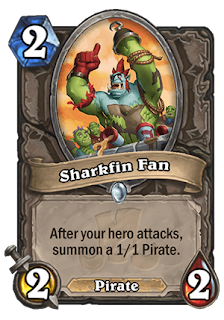 |
| Carmen says – 17 |
 |
| Carmen says – 21 |
Shirvallah, the Tiger: Omg a tiger! Very exciting stuff. I think the success of this card depends on how quickly you can drop its cost down to something reasonable, like 5 mana, at which point it’s an insane midrange and control minion. The “Zilliax effect” on a board state is quite significant, and with 7 attack this trades into almost any commonly played minion. After the divine shield goes away you’re left with a 5-health body, which is significant enough to warrant premium removal or trades from more than one minion.
 |
| Carmen says – 14 |
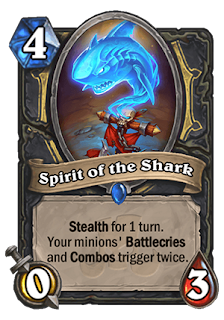 |
| Carmen says – 15 |
Spirit of the Shark: This, on the other hand, is a not-a-totem that does get me excited. I mentioned previously how Stealth, even temporary, is exactly what Brann-type cards needed, and in this case this is literally Brann Bronzebeard’s effect, with the added benefit of working with Combo (which behaves exactly like Battlecry on minions, but it’s not the same thing and doesn’t work with Brann himself). We know that Brann has seen pretty much constant play during his time in Standard and continues to shine in Wild, so obviously this effect is very powerful. Even with the increase in cost, the added “fix” should more than compensate and theoretically turn this into a staple.
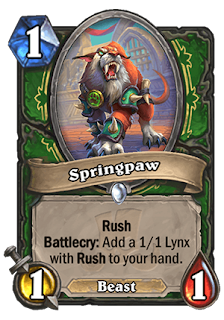 |
| Carmen says – 17 |
Springpaw: Another very simple card that makes me happy. For 1 mana more, you can now give your Alleycat and Tabbycat the Rush ability. This card is obvious, it’s a tad boring but also powerful. Subject to beast synergies galore, it could definitely see play when Hunter moves back to being a more aggressive class, as I don’t see it fitting into the currently played slow Hunter decks.
 |
| Carmen says – 22 |
Sul’thraze: During the reveal I wasn’t very excited for this weapon, but the more I think about cards like Captain Greenskin and Upgrade, the more I like it. The Overkill mechanic seems like a perfect fit for such a massive weapon, and in fact a little bit scary. Supercolider is a card that surprised most people with how useful it is, and even though this can’t go in a Warrior deck that can Tank Up all day long, it also hits smaller stuff on average. I don’t know if Pirate Warrior will be making a return, but it certainly could be a curve-topper in an aggressive deck just as easily as a controlling tool.
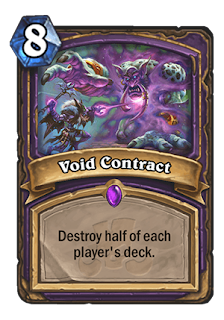 |
| Carmen says – 6 (And that’s a very generous 6.) |
Void Contract: Very few card reveals make me really giddy. The first time I saw Gnomeferatu felt pretty much the same way as when I saw this card. Is it playable, does it go in a deck? Who cares?! What’s important is the implication of its existence, the possibilities. Cards like these show Blizzard’s willingness to move into a very dangerous space – the realm of Thoughtseize and, old gods forbid, the real of Hymn to Tourach. As a card game matures, combinations of cards will emerge that create unfun experiences, aka combos. Not that there’s anything fun about losing half of your deck, don’t get me wrong, but it’s certainly an important tool that now exists. And I love how they are shoving all of these in the Warlock class – an easily hate-able and exploited Life Tap-based class.
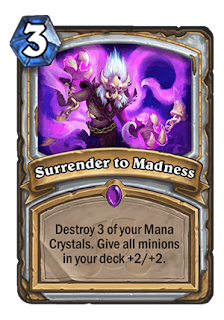 |
| Carmen says – 3rR0r |
Surrender to Madness: Leaving the worst for last, and to illustrate exactly why I’ll go deep into card game theory because designs like this are just that baffling.

